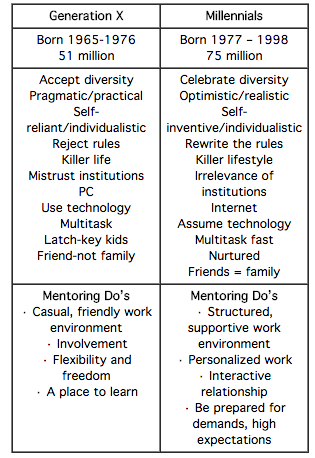Content Marketing Services in India
We Gen-Xers know that everybody wants to rule the world, and we think we still do. We don’t wanna stop believing and would rather keep partying like it’s 1999. But, news flash! We don’t rule the world anymore. A new generation has barreled in and are demanding their place in the digital landscape.
It’s fascinating to see how different generations grow, develop and approach life differently. Sure there are always crossovers and similarities - after all, we’re all human. At the same time, the proverbial generation gap was coined for a reason. There are always defining characteristics for each generation, as we touched on in our blog last month Do Your Buyer Personals Include Millennials? and as The American Bar points out in this chart, highlighting the differences between these two generations:

While those of us who are Gen-X content marketers wanna cry, “Don’t you forget about me,” we need to get used the idea that these kids are now adults who are very different from us in the way they approach digital media. The New York Times said that millennials are “so wanted by marketers” that “businesses are terrified that if they don’t snare them now, they’ll miss the chance.” The millennials are saying hello, and we need to make sure it’s them we’re looking for.

They are fluid between multiple devices
It’s hard to track these buggers. Because millennials have grown with the digital revolution, they are quick to adopt new technology. As a whole, they don’t get attached to a specific device or platform… when something newer and better comes out, they want it. If it’s more efficient - they are there. The great challenge then lies in tracking their online behaviors, since they are hopping from one device to the next. That’s where traditional marketing has become more of a scattershot approach - throwing out something wherever you can and hoping you hit something.This is why inbound marketing is on the rise and is so powerful in actually reaching this generation. You’re not worried about what device they’re on, because they will be coming to you.

But that also means your inbound marketing strategy must now include an optimized mobile content strategy. According to comScore’s recent Global Mobile Platform Report, 61 percent of total digital media time in the US is spent with smartphones and tablets, while 39 percent is on the desktop. That means more people are only interacting with digital content on mobile devices, and you can bet millennials are a part of this group.
They don’t like email
Gen-Xer: “Hey, I emailed you … didn’t you get it?” Millennial: “I haven’t checked my email in a week.” This is a common frustration Gen-Xers have with millennials. We’re all about email. C’mon... it was our first love of the digital age and it’s a hard habit to break. Millennials just don’t like email so much… sure they may have to use it at work or to get some coupons for H&M, but in their personal life, they’ll be texting, Facebook messaging, Tweeting, etc.What a disappointment this is for email marketing campaigns where low open percentages are accepted as the way of life. Again, they’re just throwing their marketing in the dark and hoping it will stick. And once again, this shows the growing importance of inbound marketing where this group is able to engage with you on their terms.
Reviews are everything
Social media is part of the very fabric of this generation. Millennials will look to what’s trending across the social networks before they make their decisions. Gen-Xers are more apt to buy a product in good faith that it will do what it’s supposed to do and then simply return it if they’re not happy with it.Not so with millennials. Online personal reviews are everything with these guys. They will take their time to thoroughly research a product before buying. In this way, they have a general distrust of the corporate world and traditional advertising. They will look to the reviews in detail and see what the online buzz is before moving towards a purchase.
This is similar to how influencer marketing works. By sharing your content through targeting the influencers in your industry, this approach allows businesses to
Summary
As with any generation, millennials are a complex group and we need to rethink our strategies on how to reach them effectively. Is your marketing strategy just living on a prayer? Are your business’ true colors shining through? If you need the help of an inbound marketing agency to effectively reach this generation, contact us today.Janelle Zander